BSBADV603 Manage Advertising Production: Detailed Assessment Solution
VerifiedAdded on 2023/06/11
|9
|2303
|500
Homework Assignment
AI Summary
This document presents a detailed solution to an assessment on managing advertising production (BSBADV603). It covers key areas such as the difference between mission and vision statements, features of an effective vision statement, specialist services for strategic planning, and PEST analysis with examples. The solution also addresses principles like equal opportunity, codes of practice, and national privacy principles, along with workplace safety regulations. Furthermore, it outlines strategies for risk management, including identifying intervention points, implementing action plans, and managing intellectual property risks. The document concludes by discussing the importance of values in organizations and how to determine company values for a new enterprise, providing a comprehensive overview of the assessment topics. Desklib is a platform where students can find similar solved assignments.

Assessment: BSBADV603 Manage Advertising Production
Assessment 4
Assessment 4
Paraphrase This Document
Need a fresh take? Get an instant paraphrase of this document with our AI Paraphraser
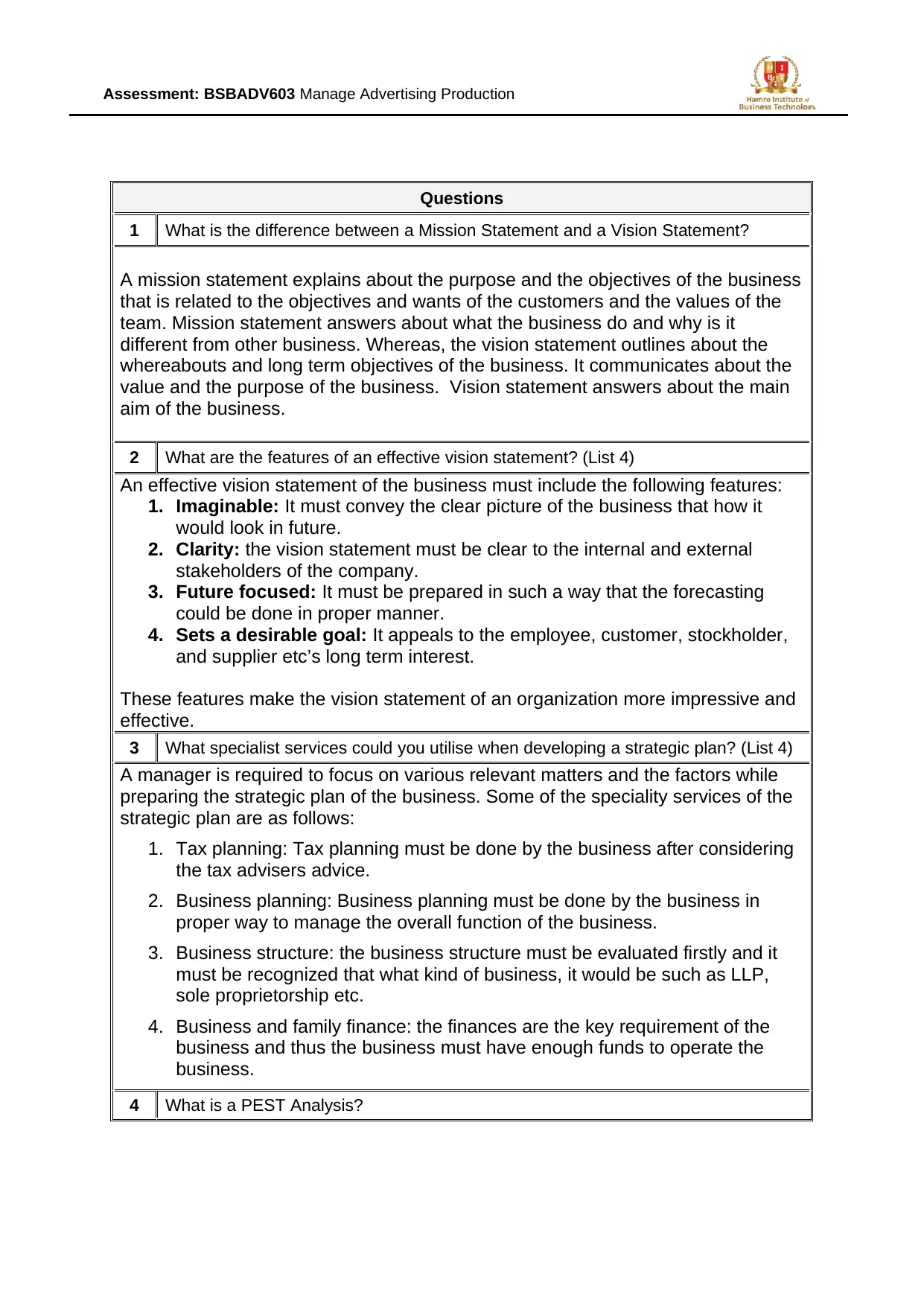
Assessment: BSBADV603 Manage Advertising Production
Questions
1 What is the difference between a Mission Statement and a Vision Statement?
A mission statement explains about the purpose and the objectives of the business
that is related to the objectives and wants of the customers and the values of the
team. Mission statement answers about what the business do and why is it
different from other business. Whereas, the vision statement outlines about the
whereabouts and long term objectives of the business. It communicates about the
value and the purpose of the business. Vision statement answers about the main
aim of the business.
2 What are the features of an effective vision statement? (List 4)
An effective vision statement of the business must include the following features:
1. Imaginable: It must convey the clear picture of the business that how it
would look in future.
2. Clarity: the vision statement must be clear to the internal and external
stakeholders of the company.
3. Future focused: It must be prepared in such a way that the forecasting
could be done in proper manner.
4. Sets a desirable goal: It appeals to the employee, customer, stockholder,
and supplier etc’s long term interest.
These features make the vision statement of an organization more impressive and
effective.
3 What specialist services could you utilise when developing a strategic plan? (List 4)
A manager is required to focus on various relevant matters and the factors while
preparing the strategic plan of the business. Some of the speciality services of the
strategic plan are as follows:
1. Tax planning: Tax planning must be done by the business after considering
the tax advisers advice.
2. Business planning: Business planning must be done by the business in
proper way to manage the overall function of the business.
3. Business structure: the business structure must be evaluated firstly and it
must be recognized that what kind of business, it would be such as LLP,
sole proprietorship etc.
4. Business and family finance: the finances are the key requirement of the
business and thus the business must have enough funds to operate the
business.
4 What is a PEST Analysis?
Questions
1 What is the difference between a Mission Statement and a Vision Statement?
A mission statement explains about the purpose and the objectives of the business
that is related to the objectives and wants of the customers and the values of the
team. Mission statement answers about what the business do and why is it
different from other business. Whereas, the vision statement outlines about the
whereabouts and long term objectives of the business. It communicates about the
value and the purpose of the business. Vision statement answers about the main
aim of the business.
2 What are the features of an effective vision statement? (List 4)
An effective vision statement of the business must include the following features:
1. Imaginable: It must convey the clear picture of the business that how it
would look in future.
2. Clarity: the vision statement must be clear to the internal and external
stakeholders of the company.
3. Future focused: It must be prepared in such a way that the forecasting
could be done in proper manner.
4. Sets a desirable goal: It appeals to the employee, customer, stockholder,
and supplier etc’s long term interest.
These features make the vision statement of an organization more impressive and
effective.
3 What specialist services could you utilise when developing a strategic plan? (List 4)
A manager is required to focus on various relevant matters and the factors while
preparing the strategic plan of the business. Some of the speciality services of the
strategic plan are as follows:
1. Tax planning: Tax planning must be done by the business after considering
the tax advisers advice.
2. Business planning: Business planning must be done by the business in
proper way to manage the overall function of the business.
3. Business structure: the business structure must be evaluated firstly and it
must be recognized that what kind of business, it would be such as LLP,
sole proprietorship etc.
4. Business and family finance: the finances are the key requirement of the
business and thus the business must have enough funds to operate the
business.
4 What is a PEST Analysis?
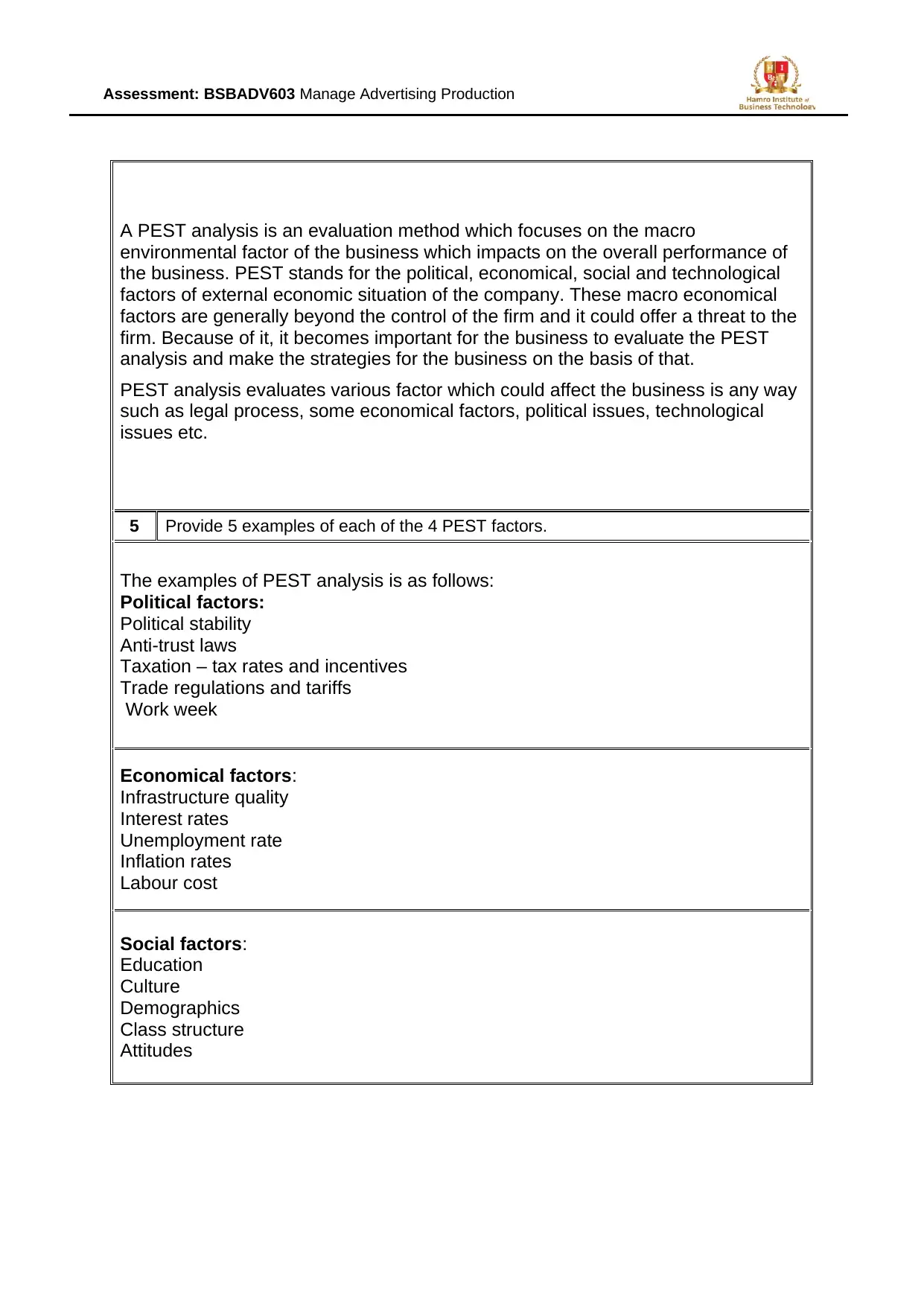
Assessment: BSBADV603 Manage Advertising Production
A PEST analysis is an evaluation method which focuses on the macro
environmental factor of the business which impacts on the overall performance of
the business. PEST stands for the political, economical, social and technological
factors of external economic situation of the company. These macro economical
factors are generally beyond the control of the firm and it could offer a threat to the
firm. Because of it, it becomes important for the business to evaluate the PEST
analysis and make the strategies for the business on the basis of that.
PEST analysis evaluates various factor which could affect the business is any way
such as legal process, some economical factors, political issues, technological
issues etc.
5 Provide 5 examples of each of the 4 PEST factors.
The examples of PEST analysis is as follows:
Political factors:
Political stability
Anti-trust laws
Taxation – tax rates and incentives
Trade regulations and tariffs
Work week
Economical factors:
Infrastructure quality
Interest rates
Unemployment rate
Inflation rates
Labour cost
Social factors:
Education
Culture
Demographics
Class structure
Attitudes
A PEST analysis is an evaluation method which focuses on the macro
environmental factor of the business which impacts on the overall performance of
the business. PEST stands for the political, economical, social and technological
factors of external economic situation of the company. These macro economical
factors are generally beyond the control of the firm and it could offer a threat to the
firm. Because of it, it becomes important for the business to evaluate the PEST
analysis and make the strategies for the business on the basis of that.
PEST analysis evaluates various factor which could affect the business is any way
such as legal process, some economical factors, political issues, technological
issues etc.
5 Provide 5 examples of each of the 4 PEST factors.
The examples of PEST analysis is as follows:
Political factors:
Political stability
Anti-trust laws
Taxation – tax rates and incentives
Trade regulations and tariffs
Work week
Economical factors:
Infrastructure quality
Interest rates
Unemployment rate
Inflation rates
Labour cost
Social factors:
Education
Culture
Demographics
Class structure
Attitudes
⊘ This is a preview!⊘
Do you want full access?
Subscribe today to unlock all pages.

Trusted by 1+ million students worldwide
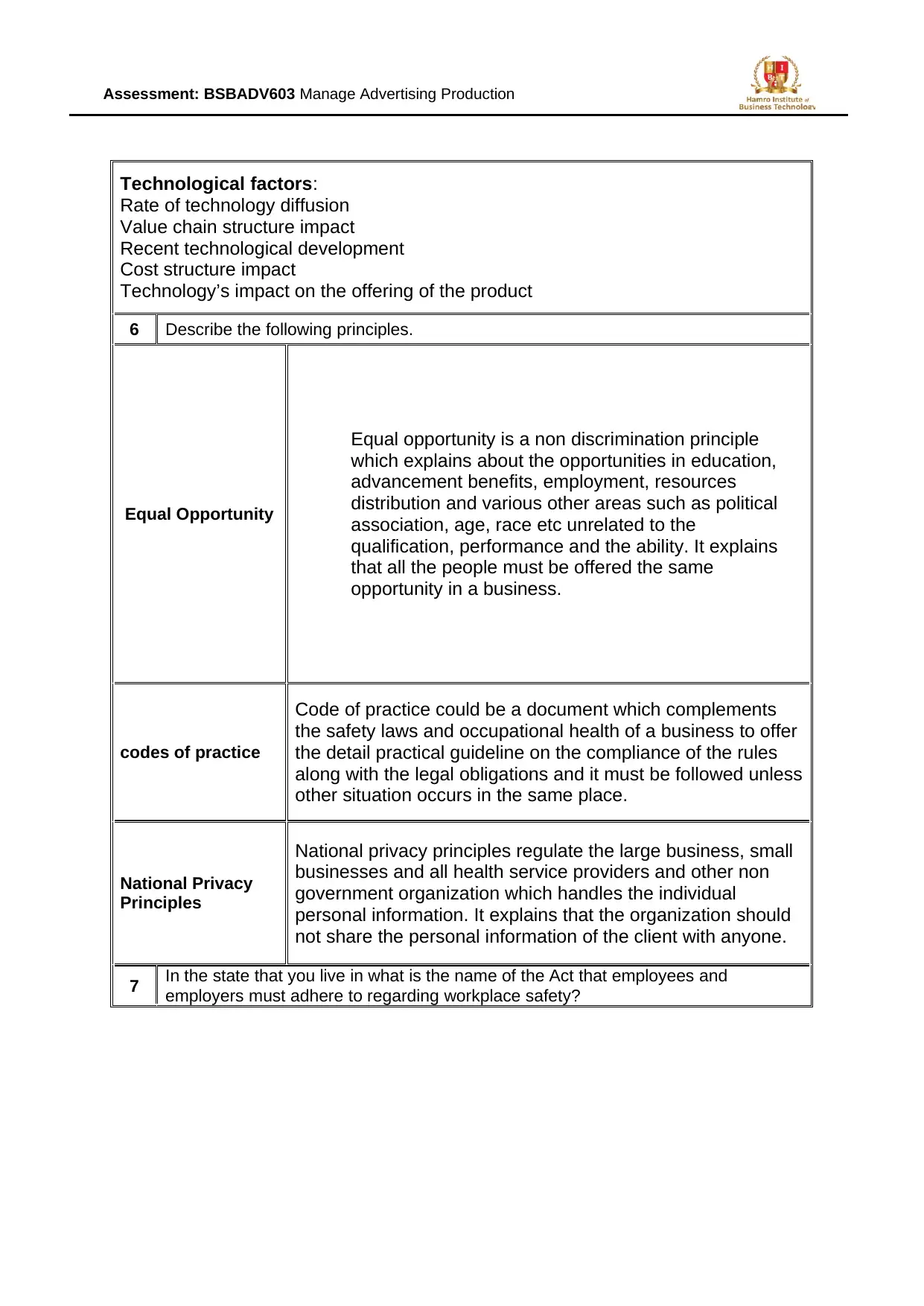
Assessment: BSBADV603 Manage Advertising Production
Technological factors:
Rate of technology diffusion
Value chain structure impact
Recent technological development
Cost structure impact
Technology’s impact on the offering of the product
6 Describe the following principles.
Equal Opportunity
Equal opportunity is a non discrimination principle
which explains about the opportunities in education,
advancement benefits, employment, resources
distribution and various other areas such as political
association, age, race etc unrelated to the
qualification, performance and the ability. It explains
that all the people must be offered the same
opportunity in a business.
codes of practice
Code of practice could be a document which complements
the safety laws and occupational health of a business to offer
the detail practical guideline on the compliance of the rules
along with the legal obligations and it must be followed unless
other situation occurs in the same place.
National Privacy
Principles
National privacy principles regulate the large business, small
businesses and all health service providers and other non
government organization which handles the individual
personal information. It explains that the organization should
not share the personal information of the client with anyone.
7 In the state that you live in what is the name of the Act that employees and
employers must adhere to regarding workplace safety?
Technological factors:
Rate of technology diffusion
Value chain structure impact
Recent technological development
Cost structure impact
Technology’s impact on the offering of the product
6 Describe the following principles.
Equal Opportunity
Equal opportunity is a non discrimination principle
which explains about the opportunities in education,
advancement benefits, employment, resources
distribution and various other areas such as political
association, age, race etc unrelated to the
qualification, performance and the ability. It explains
that all the people must be offered the same
opportunity in a business.
codes of practice
Code of practice could be a document which complements
the safety laws and occupational health of a business to offer
the detail practical guideline on the compliance of the rules
along with the legal obligations and it must be followed unless
other situation occurs in the same place.
National Privacy
Principles
National privacy principles regulate the large business, small
businesses and all health service providers and other non
government organization which handles the individual
personal information. It explains that the organization should
not share the personal information of the client with anyone.
7 In the state that you live in what is the name of the Act that employees and
employers must adhere to regarding workplace safety?
Paraphrase This Document
Need a fresh take? Get an instant paraphrase of this document with our AI Paraphraser
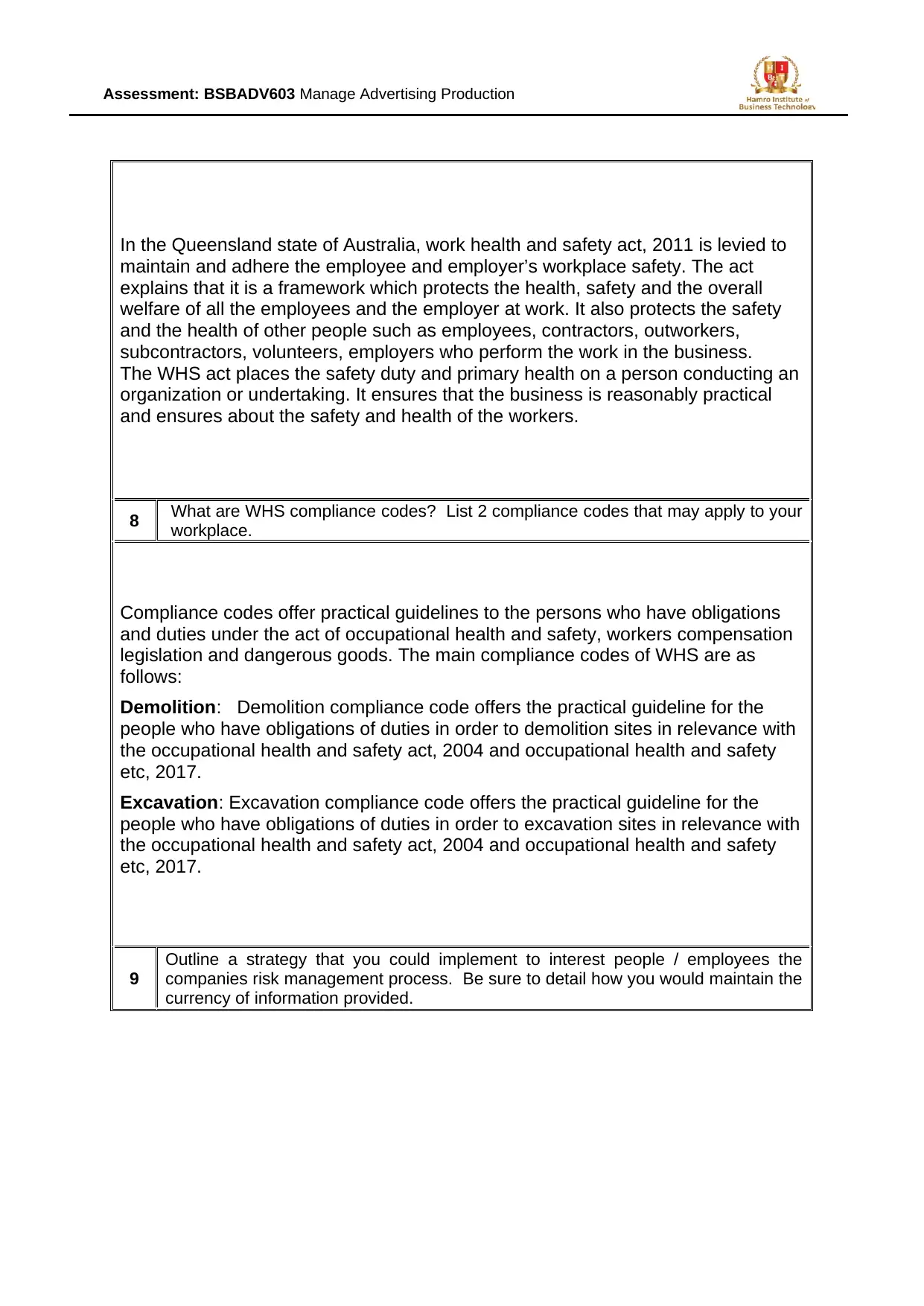
Assessment: BSBADV603 Manage Advertising Production
In the Queensland state of Australia, work health and safety act, 2011 is levied to
maintain and adhere the employee and employer’s workplace safety. The act
explains that it is a framework which protects the health, safety and the overall
welfare of all the employees and the employer at work. It also protects the safety
and the health of other people such as employees, contractors, outworkers,
subcontractors, volunteers, employers who perform the work in the business.
The WHS act places the safety duty and primary health on a person conducting an
organization or undertaking. It ensures that the business is reasonably practical
and ensures about the safety and health of the workers.
8 What are WHS compliance codes? List 2 compliance codes that may apply to your
workplace.
Compliance codes offer practical guidelines to the persons who have obligations
and duties under the act of occupational health and safety, workers compensation
legislation and dangerous goods. The main compliance codes of WHS are as
follows:
Demolition: Demolition compliance code offers the practical guideline for the
people who have obligations of duties in order to demolition sites in relevance with
the occupational health and safety act, 2004 and occupational health and safety
etc, 2017.
Excavation: Excavation compliance code offers the practical guideline for the
people who have obligations of duties in order to excavation sites in relevance with
the occupational health and safety act, 2004 and occupational health and safety
etc, 2017.
9
Outline a strategy that you could implement to interest people / employees the
companies risk management process. Be sure to detail how you would maintain the
currency of information provided.
In the Queensland state of Australia, work health and safety act, 2011 is levied to
maintain and adhere the employee and employer’s workplace safety. The act
explains that it is a framework which protects the health, safety and the overall
welfare of all the employees and the employer at work. It also protects the safety
and the health of other people such as employees, contractors, outworkers,
subcontractors, volunteers, employers who perform the work in the business.
The WHS act places the safety duty and primary health on a person conducting an
organization or undertaking. It ensures that the business is reasonably practical
and ensures about the safety and health of the workers.
8 What are WHS compliance codes? List 2 compliance codes that may apply to your
workplace.
Compliance codes offer practical guidelines to the persons who have obligations
and duties under the act of occupational health and safety, workers compensation
legislation and dangerous goods. The main compliance codes of WHS are as
follows:
Demolition: Demolition compliance code offers the practical guideline for the
people who have obligations of duties in order to demolition sites in relevance with
the occupational health and safety act, 2004 and occupational health and safety
etc, 2017.
Excavation: Excavation compliance code offers the practical guideline for the
people who have obligations of duties in order to excavation sites in relevance with
the occupational health and safety act, 2004 and occupational health and safety
etc, 2017.
9
Outline a strategy that you could implement to interest people / employees the
companies risk management process. Be sure to detail how you would maintain the
currency of information provided.
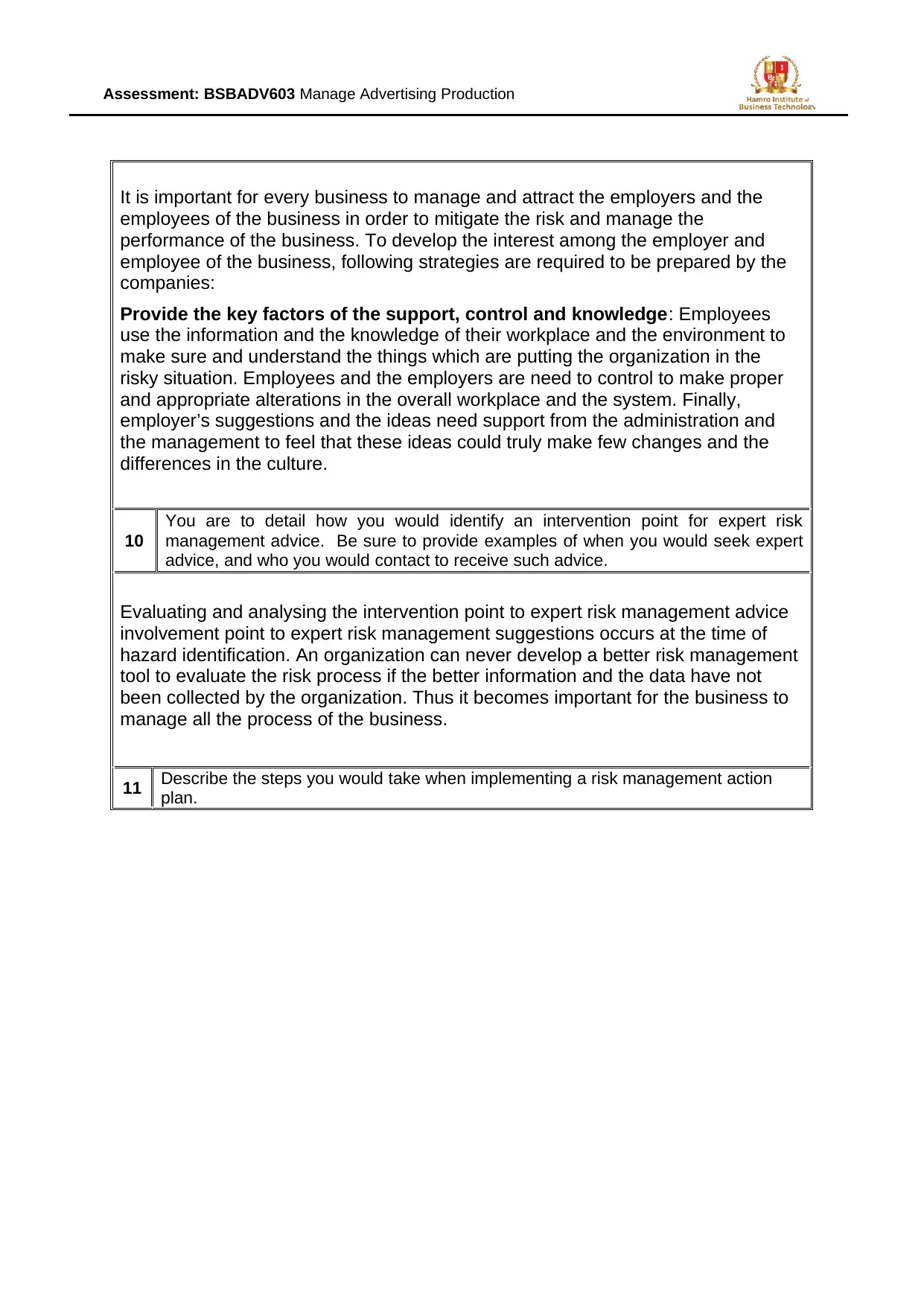
Assessment: BSBADV603 Manage Advertising Production
It is important for every business to manage and attract the employers and the
employees of the business in order to mitigate the risk and manage the
performance of the business. To develop the interest among the employer and
employee of the business, following strategies are required to be prepared by the
companies:
Provide the key factors of the support, control and knowledge: Employees
use the information and the knowledge of their workplace and the environment to
make sure and understand the things which are putting the organization in the
risky situation. Employees and the employers are need to control to make proper
and appropriate alterations in the overall workplace and the system. Finally,
employer’s suggestions and the ideas need support from the administration and
the management to feel that these ideas could truly make few changes and the
differences in the culture.
10
You are to detail how you would identify an intervention point for expert risk
management advice. Be sure to provide examples of when you would seek expert
advice, and who you would contact to receive such advice.
Evaluating and analysing the intervention point to expert risk management advice
involvement point to expert risk management suggestions occurs at the time of
hazard identification. An organization can never develop a better risk management
tool to evaluate the risk process if the better information and the data have not
been collected by the organization. Thus it becomes important for the business to
manage all the process of the business.
11 Describe the steps you would take when implementing a risk management action
plan.
It is important for every business to manage and attract the employers and the
employees of the business in order to mitigate the risk and manage the
performance of the business. To develop the interest among the employer and
employee of the business, following strategies are required to be prepared by the
companies:
Provide the key factors of the support, control and knowledge: Employees
use the information and the knowledge of their workplace and the environment to
make sure and understand the things which are putting the organization in the
risky situation. Employees and the employers are need to control to make proper
and appropriate alterations in the overall workplace and the system. Finally,
employer’s suggestions and the ideas need support from the administration and
the management to feel that these ideas could truly make few changes and the
differences in the culture.
10
You are to detail how you would identify an intervention point for expert risk
management advice. Be sure to provide examples of when you would seek expert
advice, and who you would contact to receive such advice.
Evaluating and analysing the intervention point to expert risk management advice
involvement point to expert risk management suggestions occurs at the time of
hazard identification. An organization can never develop a better risk management
tool to evaluate the risk process if the better information and the data have not
been collected by the organization. Thus it becomes important for the business to
manage all the process of the business.
11 Describe the steps you would take when implementing a risk management action
plan.
⊘ This is a preview!⊘
Do you want full access?
Subscribe today to unlock all pages.

Trusted by 1+ million students worldwide
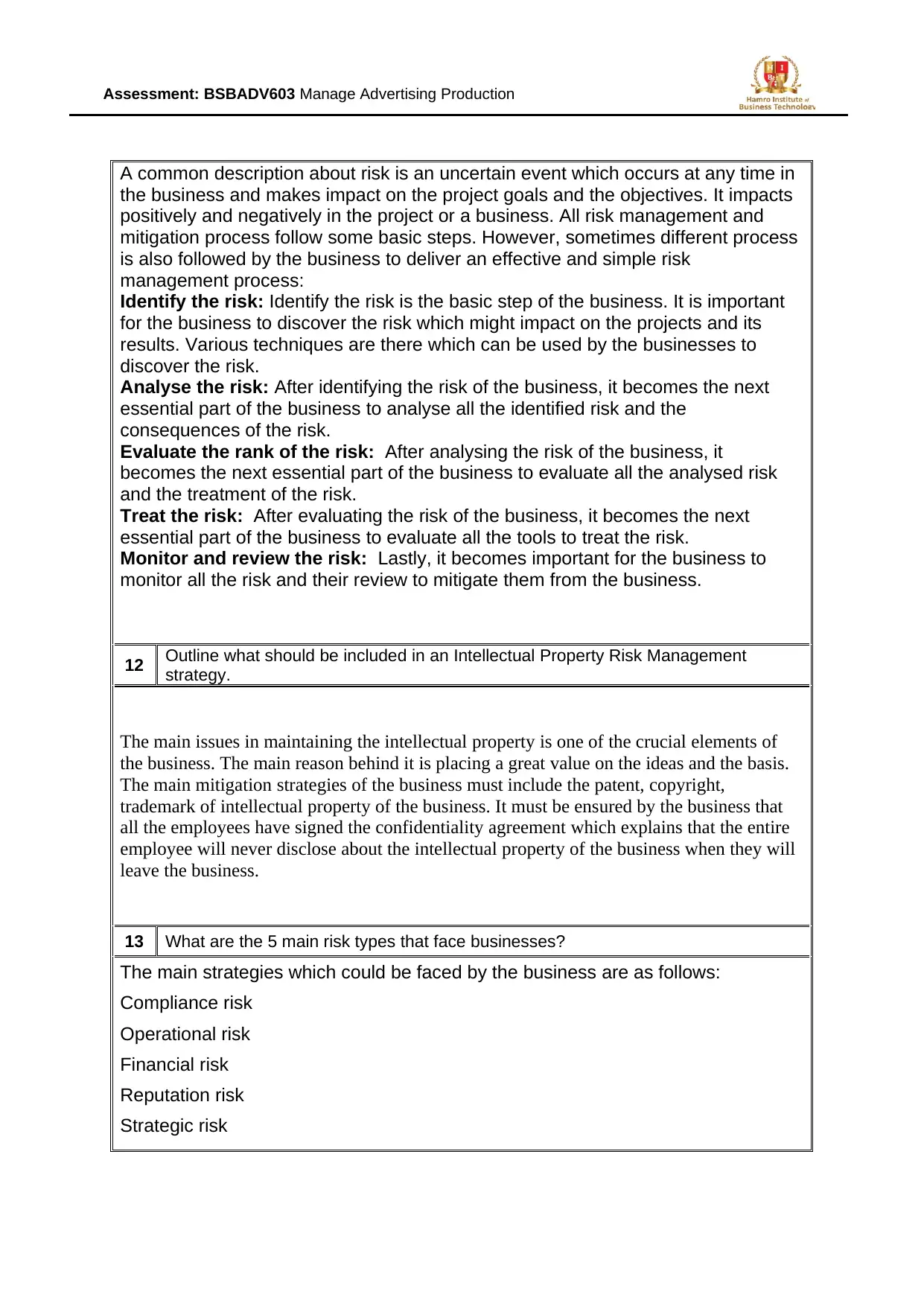
Assessment: BSBADV603 Manage Advertising Production
A common description about risk is an uncertain event which occurs at any time in
the business and makes impact on the project goals and the objectives. It impacts
positively and negatively in the project or a business. All risk management and
mitigation process follow some basic steps. However, sometimes different process
is also followed by the business to deliver an effective and simple risk
management process:
Identify the risk: Identify the risk is the basic step of the business. It is important
for the business to discover the risk which might impact on the projects and its
results. Various techniques are there which can be used by the businesses to
discover the risk.
Analyse the risk: After identifying the risk of the business, it becomes the next
essential part of the business to analyse all the identified risk and the
consequences of the risk.
Evaluate the rank of the risk: After analysing the risk of the business, it
becomes the next essential part of the business to evaluate all the analysed risk
and the treatment of the risk.
Treat the risk: After evaluating the risk of the business, it becomes the next
essential part of the business to evaluate all the tools to treat the risk.
Monitor and review the risk: Lastly, it becomes important for the business to
monitor all the risk and their review to mitigate them from the business.
12 Outline what should be included in an Intellectual Property Risk Management
strategy.
The main issues in maintaining the intellectual property is one of the crucial elements of
the business. The main reason behind it is placing a great value on the ideas and the basis.
The main mitigation strategies of the business must include the patent, copyright,
trademark of intellectual property of the business. It must be ensured by the business that
all the employees have signed the confidentiality agreement which explains that the entire
employee will never disclose about the intellectual property of the business when they will
leave the business.
13 What are the 5 main risk types that face businesses?
The main strategies which could be faced by the business are as follows:
Compliance risk
Operational risk
Financial risk
Reputation risk
Strategic risk
A common description about risk is an uncertain event which occurs at any time in
the business and makes impact on the project goals and the objectives. It impacts
positively and negatively in the project or a business. All risk management and
mitigation process follow some basic steps. However, sometimes different process
is also followed by the business to deliver an effective and simple risk
management process:
Identify the risk: Identify the risk is the basic step of the business. It is important
for the business to discover the risk which might impact on the projects and its
results. Various techniques are there which can be used by the businesses to
discover the risk.
Analyse the risk: After identifying the risk of the business, it becomes the next
essential part of the business to analyse all the identified risk and the
consequences of the risk.
Evaluate the rank of the risk: After analysing the risk of the business, it
becomes the next essential part of the business to evaluate all the analysed risk
and the treatment of the risk.
Treat the risk: After evaluating the risk of the business, it becomes the next
essential part of the business to evaluate all the tools to treat the risk.
Monitor and review the risk: Lastly, it becomes important for the business to
monitor all the risk and their review to mitigate them from the business.
12 Outline what should be included in an Intellectual Property Risk Management
strategy.
The main issues in maintaining the intellectual property is one of the crucial elements of
the business. The main reason behind it is placing a great value on the ideas and the basis.
The main mitigation strategies of the business must include the patent, copyright,
trademark of intellectual property of the business. It must be ensured by the business that
all the employees have signed the confidentiality agreement which explains that the entire
employee will never disclose about the intellectual property of the business when they will
leave the business.
13 What are the 5 main risk types that face businesses?
The main strategies which could be faced by the business are as follows:
Compliance risk
Operational risk
Financial risk
Reputation risk
Strategic risk
Paraphrase This Document
Need a fresh take? Get an instant paraphrase of this document with our AI Paraphraser
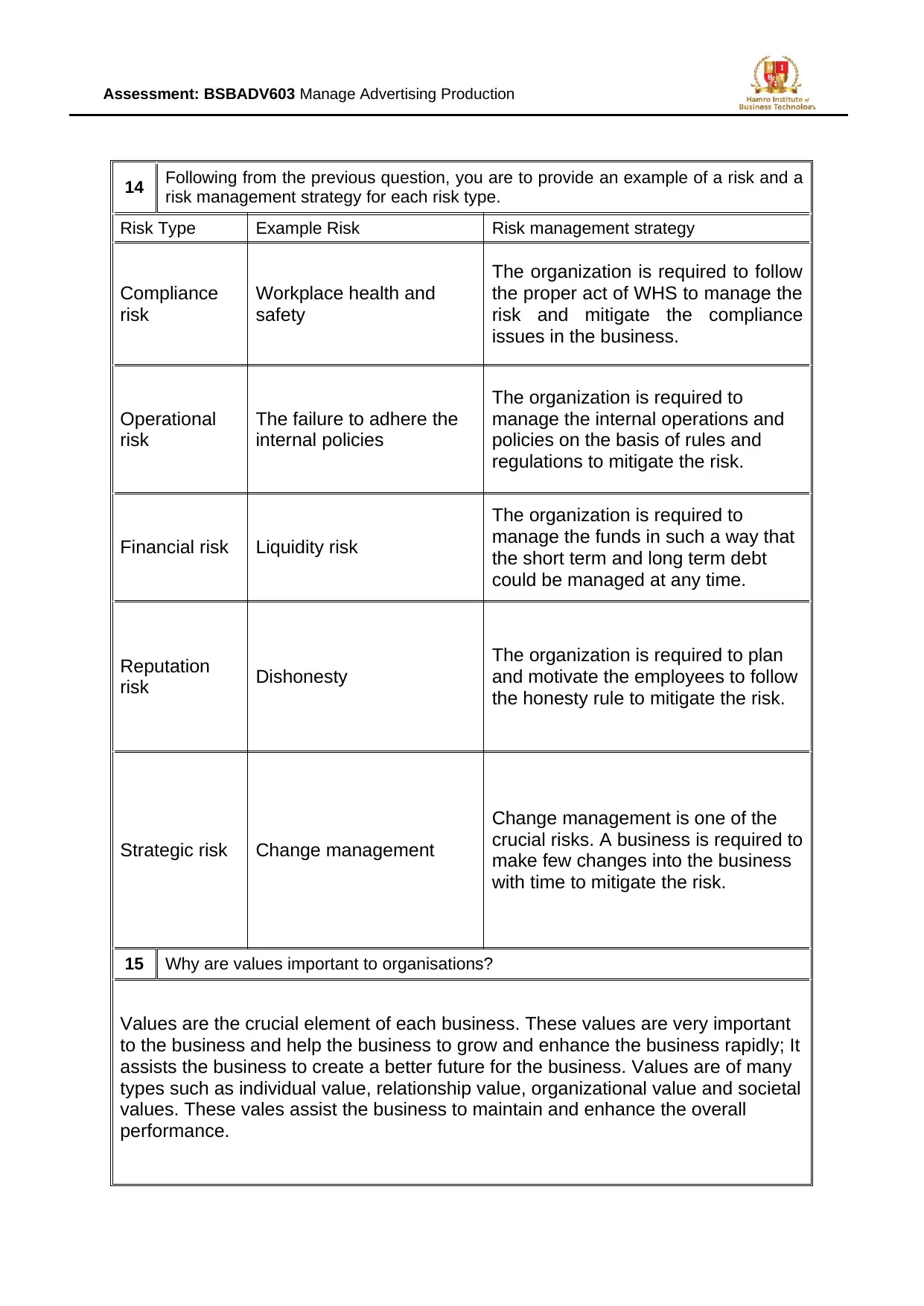
Assessment: BSBADV603 Manage Advertising Production
14 Following from the previous question, you are to provide an example of a risk and a
risk management strategy for each risk type.
Risk Type Example Risk Risk management strategy
Compliance
risk
Workplace health and
safety
The organization is required to follow
the proper act of WHS to manage the
risk and mitigate the compliance
issues in the business.
Operational
risk
The failure to adhere the
internal policies
The organization is required to
manage the internal operations and
policies on the basis of rules and
regulations to mitigate the risk.
Financial risk Liquidity risk
The organization is required to
manage the funds in such a way that
the short term and long term debt
could be managed at any time.
Reputation
risk Dishonesty
The organization is required to plan
and motivate the employees to follow
the honesty rule to mitigate the risk.
Strategic risk Change management
Change management is one of the
crucial risks. A business is required to
make few changes into the business
with time to mitigate the risk.
15 Why are values important to organisations?
Values are the crucial element of each business. These values are very important
to the business and help the business to grow and enhance the business rapidly; It
assists the business to create a better future for the business. Values are of many
types such as individual value, relationship value, organizational value and societal
values. These vales assist the business to maintain and enhance the overall
performance.
14 Following from the previous question, you are to provide an example of a risk and a
risk management strategy for each risk type.
Risk Type Example Risk Risk management strategy
Compliance
risk
Workplace health and
safety
The organization is required to follow
the proper act of WHS to manage the
risk and mitigate the compliance
issues in the business.
Operational
risk
The failure to adhere the
internal policies
The organization is required to
manage the internal operations and
policies on the basis of rules and
regulations to mitigate the risk.
Financial risk Liquidity risk
The organization is required to
manage the funds in such a way that
the short term and long term debt
could be managed at any time.
Reputation
risk Dishonesty
The organization is required to plan
and motivate the employees to follow
the honesty rule to mitigate the risk.
Strategic risk Change management
Change management is one of the
crucial risks. A business is required to
make few changes into the business
with time to mitigate the risk.
15 Why are values important to organisations?
Values are the crucial element of each business. These values are very important
to the business and help the business to grow and enhance the business rapidly; It
assists the business to create a better future for the business. Values are of many
types such as individual value, relationship value, organizational value and societal
values. These vales assist the business to maintain and enhance the overall
performance.
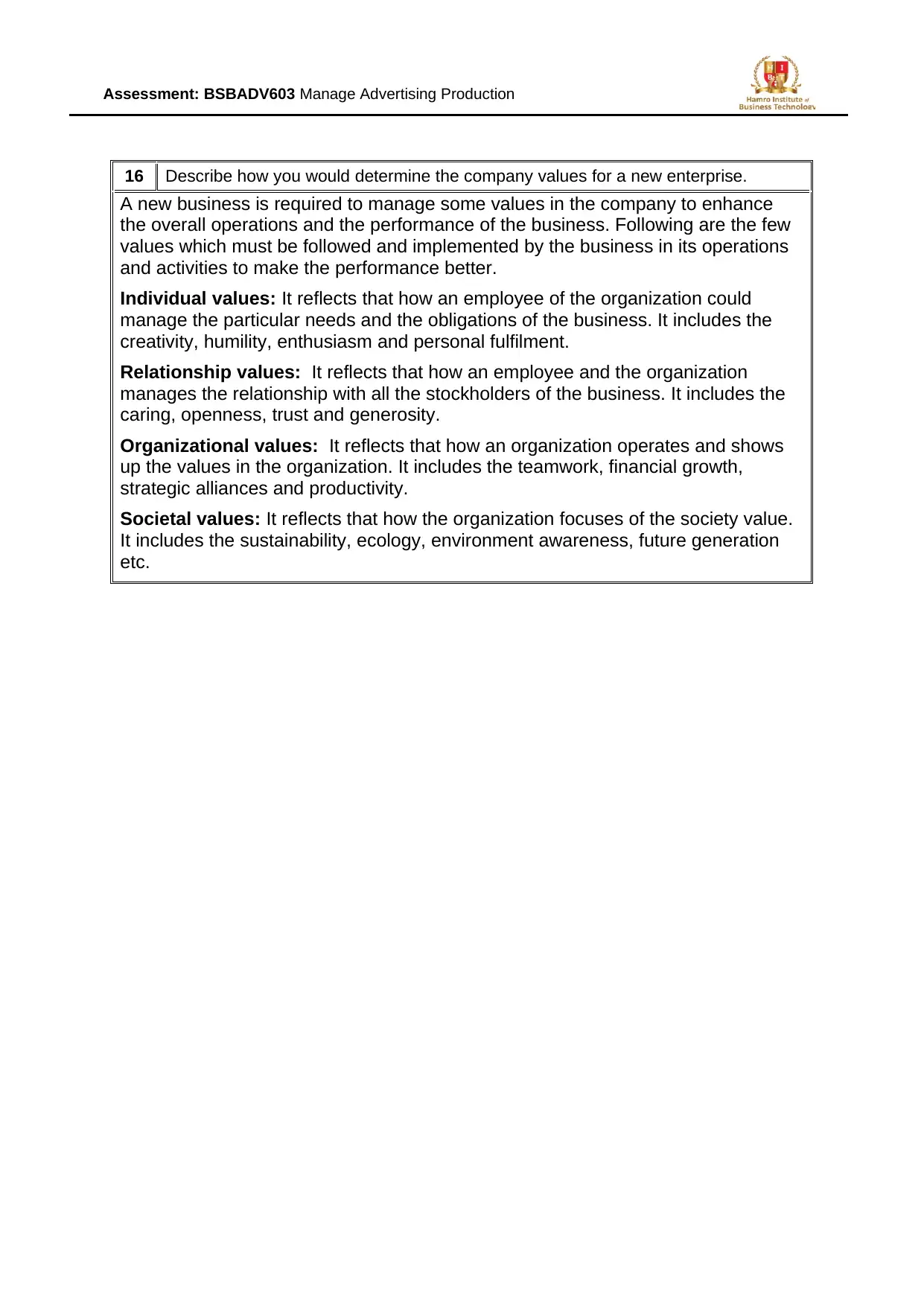
Assessment: BSBADV603 Manage Advertising Production
16 Describe how you would determine the company values for a new enterprise.
A new business is required to manage some values in the company to enhance
the overall operations and the performance of the business. Following are the few
values which must be followed and implemented by the business in its operations
and activities to make the performance better.
Individual values: It reflects that how an employee of the organization could
manage the particular needs and the obligations of the business. It includes the
creativity, humility, enthusiasm and personal fulfilment.
Relationship values: It reflects that how an employee and the organization
manages the relationship with all the stockholders of the business. It includes the
caring, openness, trust and generosity.
Organizational values: It reflects that how an organization operates and shows
up the values in the organization. It includes the teamwork, financial growth,
strategic alliances and productivity.
Societal values: It reflects that how the organization focuses of the society value.
It includes the sustainability, ecology, environment awareness, future generation
etc.
16 Describe how you would determine the company values for a new enterprise.
A new business is required to manage some values in the company to enhance
the overall operations and the performance of the business. Following are the few
values which must be followed and implemented by the business in its operations
and activities to make the performance better.
Individual values: It reflects that how an employee of the organization could
manage the particular needs and the obligations of the business. It includes the
creativity, humility, enthusiasm and personal fulfilment.
Relationship values: It reflects that how an employee and the organization
manages the relationship with all the stockholders of the business. It includes the
caring, openness, trust and generosity.
Organizational values: It reflects that how an organization operates and shows
up the values in the organization. It includes the teamwork, financial growth,
strategic alliances and productivity.
Societal values: It reflects that how the organization focuses of the society value.
It includes the sustainability, ecology, environment awareness, future generation
etc.
⊘ This is a preview!⊘
Do you want full access?
Subscribe today to unlock all pages.

Trusted by 1+ million students worldwide
1 out of 9
Related Documents
Your All-in-One AI-Powered Toolkit for Academic Success.
+13062052269
info@desklib.com
Available 24*7 on WhatsApp / Email
![[object Object]](/_next/static/media/star-bottom.7253800d.svg)
Unlock your academic potential
Copyright © 2020–2025 A2Z Services. All Rights Reserved. Developed and managed by ZUCOL.




